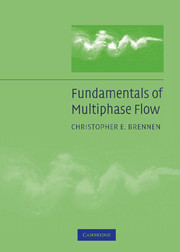Book contents
- Frontmatter
- Contents
- Preface
- Nomenclature
- 1 Introduction to Multiphase Flow
- 2 Single-Particle Motion
- 3 Bubble or Droplet Translation
- 4 Bubble Growth and Collapse
- 5 Cavitation
- 6 Boiling and Condensation
- 7 Flow Patterns
- 8 Internal Flow Energy Conversion
- 9 Homogeneous Flows
- 10 Flows with Bubble Dynamics
- 11 Flows with Gas Dynamics
- 12 Sprays
- 13 Granular Flows
- 14 Drift Flux Models
- 15 System Instabilities
- 16 Kinematic Waves
- Bibliography
- Index
15 - System Instabilities
Published online by Cambridge University Press: 05 June 2014
- Frontmatter
- Contents
- Preface
- Nomenclature
- 1 Introduction to Multiphase Flow
- 2 Single-Particle Motion
- 3 Bubble or Droplet Translation
- 4 Bubble Growth and Collapse
- 5 Cavitation
- 6 Boiling and Condensation
- 7 Flow Patterns
- 8 Internal Flow Energy Conversion
- 9 Homogeneous Flows
- 10 Flows with Bubble Dynamics
- 11 Flows with Gas Dynamics
- 12 Sprays
- 13 Granular Flows
- 14 Drift Flux Models
- 15 System Instabilities
- 16 Kinematic Waves
- Bibliography
- Index
Summary
Introduction
One of the characteristics of multiphase flows with which the engineer has to contend is that they often manifest instabilities that have no equivalent in single-phase flow (see, for example, Boure et al. 1973, Ishii 1982, Gouesbet and Berlemont 1993). Often the result is the occurence of large pressure, flow-rate, or volume-fraction oscillations that, at best, disrupt the expected behavior of the multiphase flow system (and thus decrease the reliability and life of the components, Makay and Szamody 1978) and, at worst, can lead to serious flow stoppage or structural failure (see, for example, NASA 1970, Wade 1974). Moreover, in many systems (such as pump and turbine installations) the trend toward higher rotational speeds and higher power densities increases the severity of the problem because higher flow velocities increase the potential for fluid/structure interaction problems. This chapter focuses on internal flow systems and the multiphase flow instabilities that occur in them.
System Structure
In the discussion and analysis of system stability, we consider that the system has been divided into its components, each identified by its index, k, as shown in Figure 15.1 where each component is represented by a box. The connecting lines do not depict lengths of pipe that are themselves components. Rather, the lines simply show how the components are connected. More specifically they represent specific locations at which the system has been divided up; these points are called the nodes of the system and are denoted by the index, i.
- Type
- Chapter
- Information
- Fundamentals of Multiphase Flow , pp. 284 - 301Publisher: Cambridge University PressPrint publication year: 2005

